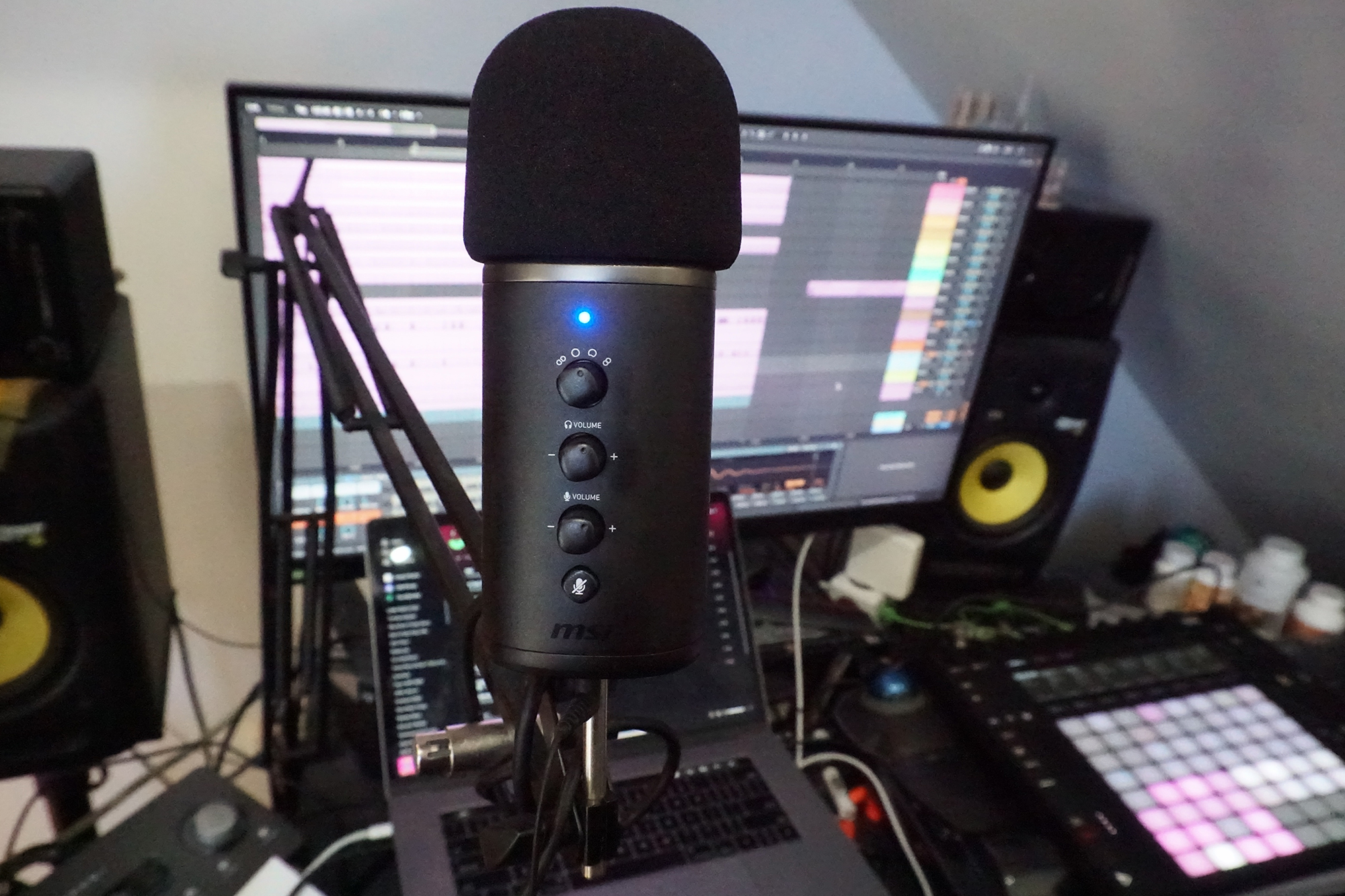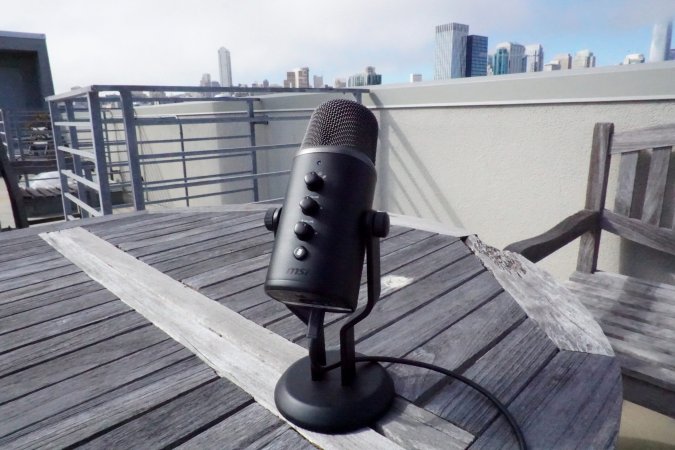

We may earn revenue from the products available on this page and participate in affiliate programs. Learn more ›
When an electronics company known for one thing makes a lateral move into a new device type, it can be cause for celebration or scrutiny. MSI famously makes gaming computers, hardware, and peripherals. However, USB microphones are now also eSports accessories and there may be as many USB mic models for sale as there are PS5 games. So, the introduction of MSI’s Immerse GV60 streaming microphone isn’t that dubious of a debut. The fact remains, however, that it’s hard for USB mics to stand out in such a crowded field. That’s why the MSI Immerse GV60 stakes its claim on comprehensive features and good audio results for a competitive price.
At $129 MSRP (typically less in the cart), the MSI Immerse GV60 costs close to or below many of our favorites, such as the Blue Microphones Yeti X or the Elgato Wave:3. Yet, for that price, it delivers just about everything you may need from a USB mic: high-resolution audio, mounting options, no-latency headphone monitoring, four pickup (polar) patterns, and convenient front-panel controls. Let’s take a closer look at what makes the GV60 a USB mic that works for any purpose—not just gaming, but also podcasting, meetings, video creation, music recording … whatever you need.
Best overall
The MSI Immerse GV60’s design
While I would not call it a copycat of the Blue Microphones Yeti and Yeti X USB mics, the MSI Immerse GV60 does take on a similar look, feel, and height to the two flagship Yetis. Like them, the GV60 is a plug-and-play USB condenser microphone with a solid metal (matte-finished aluminum) chassis and robust metal stand with a padded bottom to protect tabletop finishes. Size-wise, it’s just a bit smaller than the Yeti, while the weights are similar. Measured on a digital scale, the GV60 mic alone weighs 1.3 pounds compared to the Yeti’s 1.05 pounds, while the GV60 in its included stand weighs 2.4 pounds, while the Yeti in its stand weighs 2.9 pounds.
When mounted on the desktop stand, the GV60 swivels within the brackets for you to find the right angle, and it unscrews from the brackets so that you can mount it to a standard microphone boom arm from the 5/8-inch threaded hole on the underside of the mic. Also on the underside are the USB-C port for connecting the included 3-meter USB-C to USB-A cable to a computer or mobile device, plus a 3.5mm headphone output.
It only took about a minute to unscrew the Immerse GV60 from its stand and screw it securely onto a no-frills On-Stage MBS5000 mic boom arm, but the MSI stand’s screws have some loose washers that you must be careful not to spill onto the floor. A foam pop filter comes in the box and fits over the mic head.
Getting started with the MSI Immerse GV60
The Immerse GV60 requires no drivers or any other software to work as a plug-and-play USB mic with macOS and Windows 10 and higher machines. MSI’s website does not list mobile devices as compatible; however, I used the GV60 with both a 2018 iPad Pro iOS tablet and a Motorola Stylus G Android phone with no problems. In both cases, I plugged the mic straight into the mobile devices with a USB-C cable and the devices recognized the mic as both the audio output and audio input for recording from various apps. Whether used with a computer or mobile device, the mic draws USB power, so keep that in mind when considering battery levels.
The MSI Immerse GV60’s key features
While I mentioned a similar feel to the Immerse GV60 compared to the Blue Yeti and Yeti X, the MSI mic differs in a couple of key aspects. For one, all of its controls are on the front of the mic, where they are easy to see and reach. Also, the GV60’s 24-bit/96 kHz maximum audio resolution exceeds that of the Yeti (16-bit/48 kHz) and the Yeti X (24-bit/48 kHz). While 16-bit/48 kHz audio resolution is still typically enough for the most common use cases of a USB mic—such as podcasting, YouTube and other online videos, video conferencing, gaming, and so on—it can’t hurt to have the extra high-res capability of the GV60, whether it’s for producing music or future-proofing for emerging formats—especially when the GV60’s typical sell price is lower than both the Yeti and Yeti X.
The GV60 also has the crucial feature that almost every USB mic shares: no-latency monitoring through its headphone output. With this, you’ll be able to listen to the microphone input (i.e., your voice, or whatever is being recorded) through the mic’s headphone output in real-time, with no delay. Whether you’re recording yourself, livestreaming, or just on a Zoom meeting, the no-latency monitoring is very helpful.
And with the front-panel controls, you can conveniently adjust the level of the mic input up or down, control the volume of the headphone output, or hit the mic mute button, which instantly shuts off the mic input and turn the front-panel mic LED from blue (mic on) to red (mic off).

Four recording pickup patterns
The remaining front-panel control selects one of the Immerse GV60’s four available pickup patterns, which determine the areas around the mic capsule that diaphragms focus on while recording. MSI lists the four pickup patterns as Stereo, Omnidirectional, Unidirectional (aka cardioid), and Bidirectional (aka Figure 8).
The Unidirectional/cardioid pattern zeroes in on the front, trails off at the sides, and de-emphasizes the back—commonly used for single-person talking or singing. Omnidirectional takes in sound equally from 360 degrees around the mic and is good for capturing the entire ambiance of a space and every member of a roundtable discussion. The Stereo pattern uses the left and right channels to create a wide audio image and is well-suited to recording instruments or multiple sound sources in front of the mic. Finally, the Bidirectional pattern emphasizes both the front and back of the mic, so it’s ideal for capturing two people sitting across from each other in a conversational crossfire hurricane.
Like many other USB mics, such as the AKG Ara or the Elgato Wave:3, the GV60 is a very sensitive microphone so if you have it in Unidirectional mode, it will still pick up sounds from all over the room while it emphasizes what’s in front of the mic head. But the specialized pickup patterns perform as advertised and do have their uses. For example, when attempting to record a video chat, my computer had a problem recording the internal audio. So, I put the GV60 into Bidirectional mode so I could record the onscreen audio from speakers behind the mic and my own voice in front of the mic. It turned out to sound quite good, with clear results from both sources.
The MSI Immerse GV60’s sound
With its strong lineup of gaming computers, monitors, processors, and peripherals, MSI seems to have introduced a microphone into its product oeuvre as a gaming accessory, but the Immerse GV60 is appropriate for any type of content creator. I tested it primarily for recording sung and spoken vocals, video conferencing, and recording interviews, but also recorded drums and amplified synthesizers. I also compared the results against the aforementioned Yeti, Yeti X, Ara, and Wave:3 microphones, as well as the HyperX QuadCast S USB mic.
After testing so many USB microphones with similar features and in the same price range, it becomes clear that there isn’t a wide gap separating them in terms of the audio quality that they capture, though there are more subtle leaps in clarity. Similar to the other mics mentioned, the GV60 deftly captures minute details and has a very sensitive input, so it offered a small but noticeable rise in clarity compared to some of its competitors I had on hand. The recording levels can get very hot very fast if you turn up the input too high, however. To avoid treble spikes—and picking up the details you don’t want, like the clacking of your keyboard—it’s very helpful to have that pop filter handy and the GV60’s input volume knob on the front (though you may even find yourself playing with software noise suppressors). Other mics that don’t have that input control but still have very sensitive input levels, like the AKG Ara, can make it more challenging to make sure you’re not overdoing the input levels.
Also like most USB mics, the GV60 records sources very transparently. It’s a much higher-quality microphone than the built-in mic of a computer or mobile device, but if you’re a musician or content creator who wants a flattering, honeyed, velvety sound out of a microphone, this or any other USB mic is probably not what you want. While higher-priced condenser microphones use expensive tubes and/or transformers to color sounds with positive distortion that’s described as a “warming” or softening effect, USB microphones like the GV60 pack a lot of functionality—like a built-in audio interface that allows real-time monitoring—into a small chassis for a low price, so what you hear is what you get. You’re not buying a signature sound. But, when recording drums in a rehearsal space, I appreciated that detailing. On the other hand, when trying to sing while half-sick and not really hiding that condition, I would have preferred less of a harshly transparent microphone.
The GV60’s 24-bit/96 kHz maximum audio resolution is in the sweet spot with many newer USB mics, while some older models top out at a slightly lower level, and a few go up to 192 kHz (the AKG Lyra, a podcast favorite, for example). There’s not much audible difference between say 24-bit/48 kHz and 24-bit/96 kHz audio other than a slightly brighter presence in the high-end frequency range. And there’s no reason to dock the GV60 for not extending to 192 kHz, which is not really necessary for anything you’re likely to do with a USB mic.

So, who should buy the MSI Immerse GV60?
When there are so many USB microphones available and there’s such parity between many of them in terms of audio quality, the reasons to choose one model over another can come down to very minute details and/or personal preferences such as aesthetic appearance. The aesthetic viewpoints are obviously subjective. I personally find the Immerse GV60 visual design to be a little generic and less striking than many other options in the field. However, given that its audio results compare very evenly to some of the best USB mics, like the Yeti X and the Wave:3, yet it’s priced lower than both, the GV60 offers value. If you add in that its audio resolution is as high as you’ll need and its generous front panel controls and four pickup patterns are quite handy, this is a well-rounded USB microphone. If you’re a gamer that may also record or a podcaster that also games, the MSI Immerse GV60 is a solid streaming microphone for improving audio quality at an attractive price.

